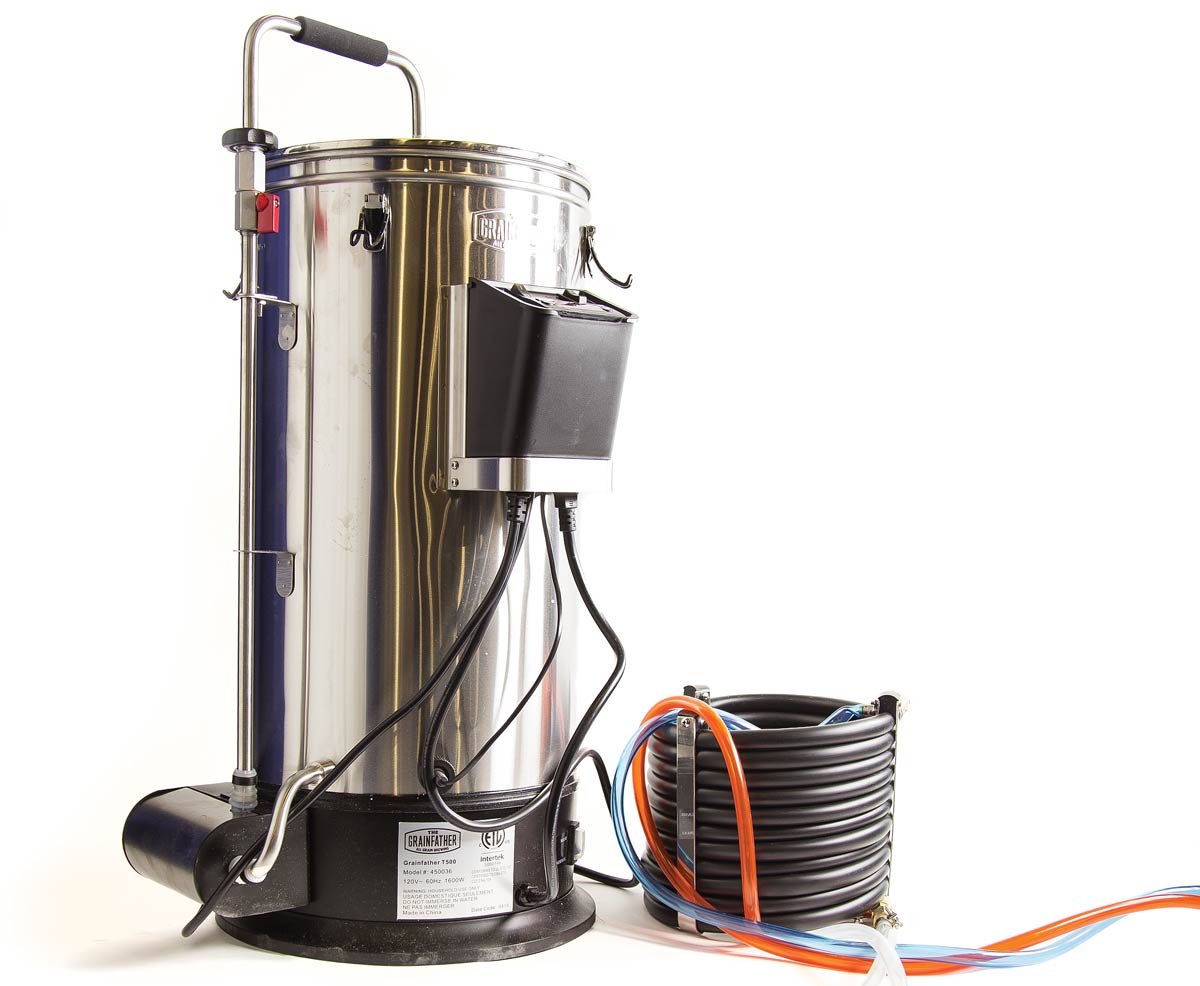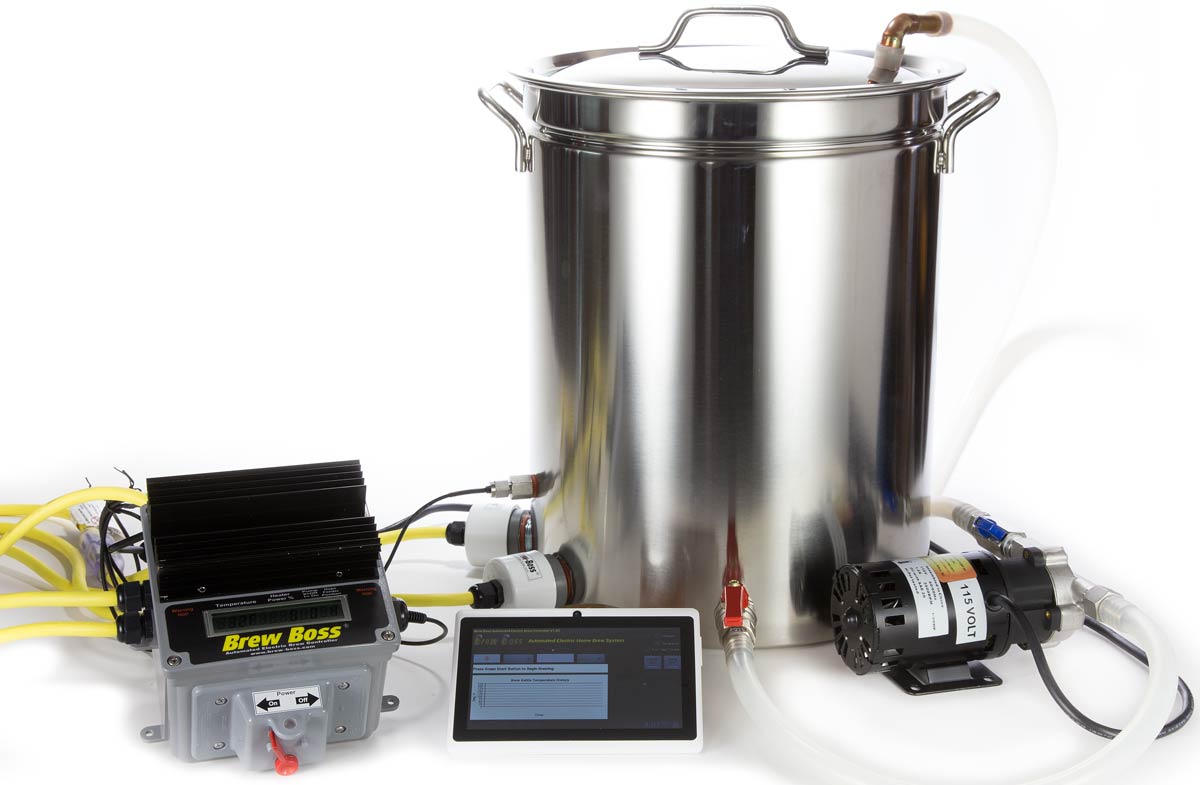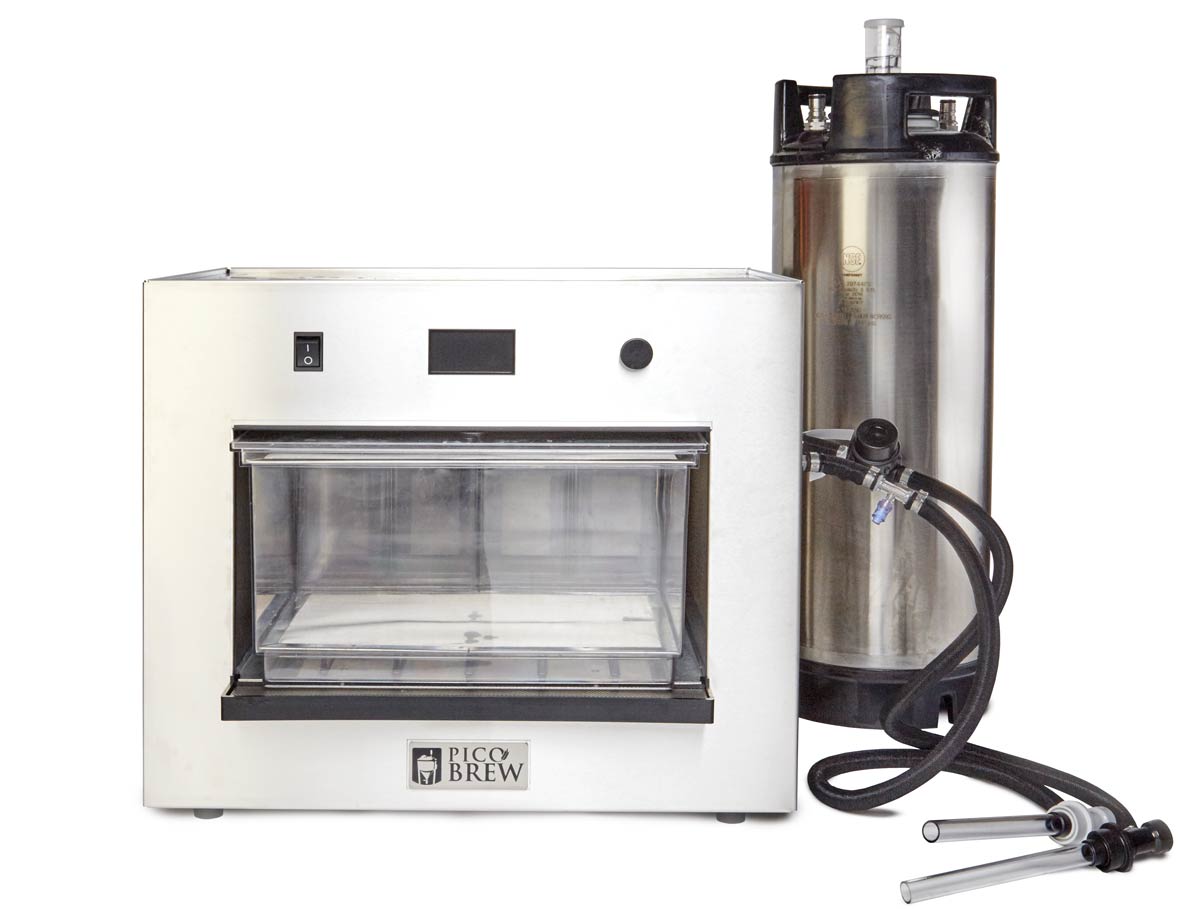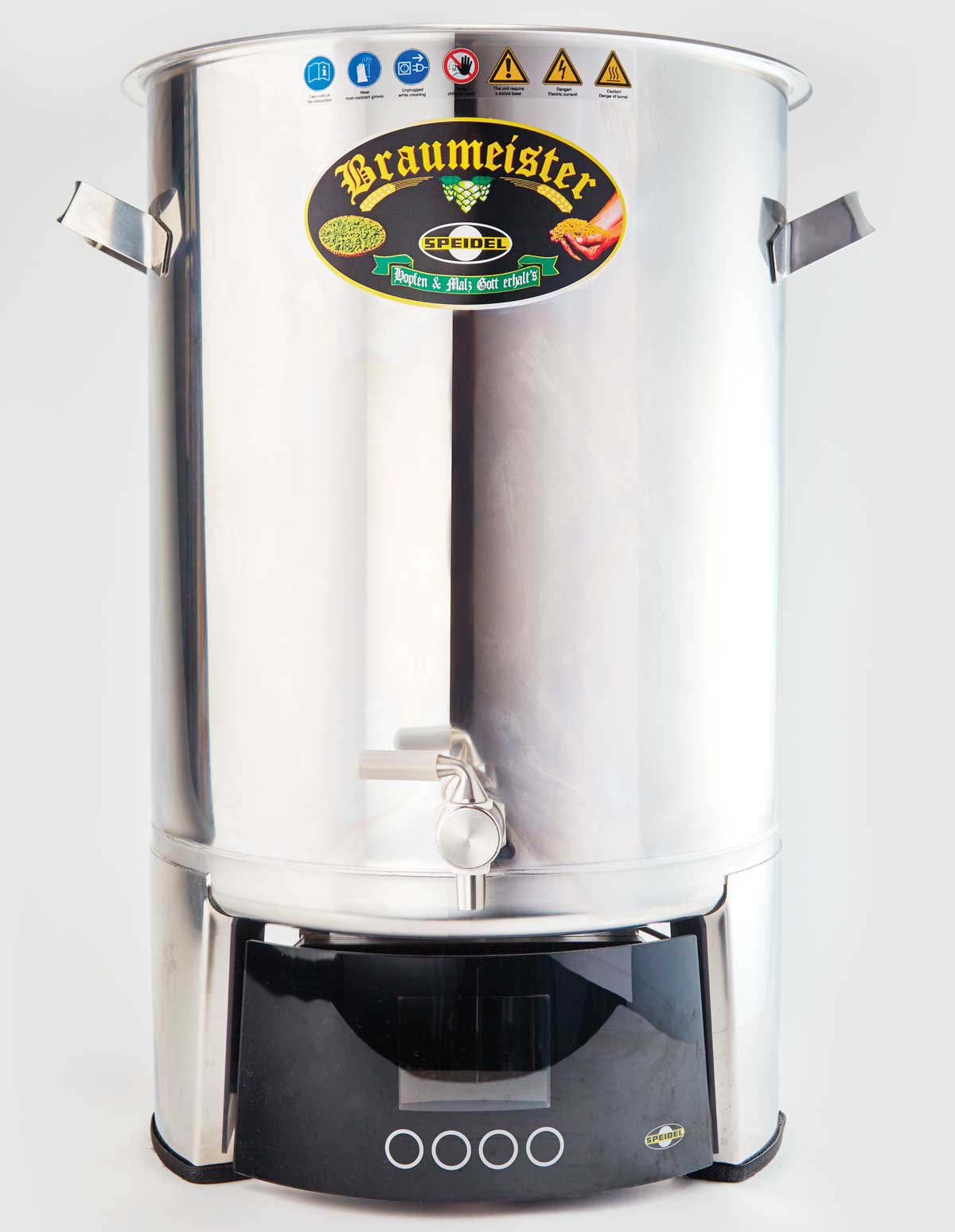An electric revolution is underway in the brewing world, with small, efficient systems at accessible price points attracting more and more brewers. How do these competing systems stack up? We took five systems into our brew lab (we added Speidel Braumeister for this update) and put them to the test to help you decide whether an electric turnkey system is for you.

The Grainfather
An all-in-one electric homebrew system with a surprisingly deep feature set (recirculating mash), moderate power requirements (runs on standard 120v household current), and an integrated control system to maintain temperatures, all at a very aggressive price point.
Test Lab Notes
PROS: The Grainfather is compact, easy to use, and thanks to the built-in pump and recirculating mash provides the ability to brew all-grain recipes almost as convincingly as a system with dedicated vessels. The temperature and pump controller are simple and straightforward making it easy to set your temperature and walk away, but the system still requires hands-on participation in the brewing process making you feel as if you are actually brewing and not just pushing buttons. The included counterflow wort chiller is very effective at dropping the wort temperature quickly as long as your tap water is cool enough. While we have 240 volt, 50 amp power in our brew lab to power our custom-built electic test system, we didn’t need it for the Grainfather—it uses standard 120 volt household power.
CONS: If you’re looking for a bombproof system, this is not quite it. The fit and finish reminded us of a 30-cup coffee percolator with relatively thin walls and less expensive fittings (which is understandable at this price point). While we didn’t encounter any issues as a result of this, if you’re hard on your equipment, it’s a consideration. In use, we experienced significant temperature fluctuation as a result of the on/off heating element (more sophisticated systems use variable power elements). Some water and wort have the potential to overheat until the recirculation pump kicks in, and the unit will overshoot your temperature goal before settling back.
An upgrade for the next version of this system would be a smarter temperature controller that could compensate for this and cycle the element on and off in a more predictive way. In addition, we’d love to see slightly more intuitive controls on the temperature controller—when we set it to “boil,” it completely ignored the actual temperature we set.
We chose to brew a test recipe with a large grain bill as well as flaked corn and flaked wheat and did have to monitor the pump closely to clear out clogs as they occurred. For more reasonable recipes this should not be an issue.
As with all units that use exposed heating elements directly below the grain bed, there is some risk of scorching while you mash. We didn’t note any off flavors from this in our finished brew, but it is something to be aware of.
This unit took the longest to hit strike temperature of all the units we tested (about an hour).
Additional Gear You’ll Need
If you need to add heated sparge water to hit your gravity, you’ll need a pot and stove to heat it. You also need hoses to attach to the water inlet and outlet of the counterflow chiller, so you’ll need a brewing space that gives you access to a sink with a threaded faucet. A fermentor is not included with the system, but the company does sell a stainless steel fermentor for use with the system.
Verdict
The Grainfather is ideal for price-conscious folks who live in apartments or small homes and need an inexpensive all-in-one system that’s capable of brewing indoors. If you’re not into tinkering, the Grainfather is a great choice, since it requires minimal assembly and no knowledge of electrical wiring. Hardcore DIYers may not be as excited with the unit since the all-in-one system takes some of the work out of brewing. But if you’re also interested in distilling, the alembic pot still attachment makes this unit more attractive. There is no other product competitive at this low price point, and we found the Grainfather to be a good value for the price.
Price
$890 for the basic unit and wort chiller. $359 for alembic pot still attachment.

Brew Boss
An electric brewing system with app-based control, modular add-ons to allow further automation, and a burly power unit that pushes two separate heating elements allowing it to plug in to standard home outlets.
Test Lab Notes
PROS: We tested the 120v system with two heating elements that require separate circuits for each element. If you don’t have accessible 240v power, this dual-element approach gives you more power and heat to achieve strike temperature and boil faster. The electrical control unit is built tough with a tough plastic casing and large heat sink. The system ships with a standard 7-inch Android tablet and custom software to control each element in the system (heating elements, recirculating pump, and additional modular elements). This software was easy to use and relatively intuitive, with convenient voice prompts at various stages of the brewing process.
We found setup to be very easy and had the entire system assembled in about ten minutes. The system is very compact and stores in a very small footprint. The included pump is very powerful and performed flawlessly.
CONS: The Brew Boss system as a whole lacks the same level of integration and polish as some of the other systems we tested and feels like what it is—stock parts repurposed into a complete system. This “value” unit is limited to brew-in-a-bag (BIAB) brewing only, although more expensive units have a recirculating infusion mash system that employs a straining container inside the kettle to hold the grains.
Out of the box, the temperature sensor jack required remounting (it was not sturdy enough to withstand shipping), but once remounted, it worked correctly.
We noticed small issues with temperature calibration while using the system—the temperature gauge consistently read 8°F (4°C) higher than the two other thermometers we checked it against.
The Android app is a smart way to automate the brewing process, but the interface for the app feels like a 90s website and could benefit from a more modern UI design. In addition, some testers found it difficult to use a water-sensitive device while brewing.
Additional Gear You’ll Need
A wort chiller is sold separately, as is fermentation equipment.
Verdict
If you live in a small space, and the batch size of the other integrated systems isn’t large enough for you, the Brew Boss offers a 10-gallon kettle for not much more than competing systems’ 5-gallon capacity. But the BIAB system is limiting, and the upgrade to their COFI mash system puts the system into a higher pricing tier.
Price
$1,299 as tested.

Blichmann Brew Easy
The Rolls-Royce of turnkey electric brew systems offers tight integration, sophisticated polish, the best electric element in the business, and modular upgrade ability… for a price.
Test Lab Notes
PROS: With the best fit and finish of any of the systems we tested, Blichmann lives up to its reputation for quality with the Brew Easy system. While it’s available in different sizes, we tested the 5-gallon version with a 240v BoilCoil electric heating element. That heating element clearly requires more power than the competing systems and would at minimum require most home users to purchase a 240v extension cord, but the benefit of that power was immediately apparent—the system reached strike temperature twice as fast as the next fastest system. In addition, the stacked coil design of the heating element created a natural convection current in the kettle.
A primary differentiating factor to Blichmann system is just how upgradeable it is. If you decide to move from a 5-gallon to a 15-gallon system, the same 240v Tower of Power electric controller can operate both. Same with the included KettleCart.
When it comes to electric operation, Blichmann has considered safety with the low-level float switch that shuts down the BoilCoil if it’s at risk of running dry. In addition, the auto-sparge system is well-thought-out with a floating stainless ball that closes the inlet valve when it reaches a certain point, so as not to overflow the pot.
Finally, as homebrewers, we appreciate systems that feel like we’re homebrewing, and not simply operating a home appliance. The Brew Easy strikes a nice balance between automation and participation, and lets you feel as if you’re brewing despite the convenience of automation.
CONS: The Brew Easy system was significantly more difficult than the other systems to set up. The build took us about an hour and a half, and at one point involved wiring the pump into the power box. The modular nature of the system, while convenient for potential upgraders, is also a drawback in that there is not a single setup guide as with other systems—it does require knowledge on the part of the user and could be intimidating for less experienced users.
The modified RIMS system works well and produced clear wort, but the location of the temperature gauge in the pump means that it must be running to get a temperature reading.
Additional Gear You’ll Need
A wort chiller. While Blichmann provided us with a Therminator wort chiller, it’s not included in the standard turnkey package.
Verdict
When testing, our immediate thought was that we should have opted for a 10-gallon system instead of the 5-gallon. For only 10 percent greater cost, the same power circuit requirement, and a marginal difference in size, we would double the amount of beer we could brew in a single batch, and $2,000 is a bit more than we would budget for a 5-gallon system. This system is ideal for quality-minded brewers who have some experience brewing all-grain but want the ease of use of a two pot system without sacrificing the beer quality of a RIMS system.
Price
$2,025 for the turnkey 5-gallon system. $199 for the Therminator wort chiller.

Picobrew Zymatic
Could brewing beer be as simple as operating a microwave? The Picobrew Zymatic aims to simplify and automate the brewing and cleanup process, and (surprisingly?), it makes great beer.
Test Lab Notes
PROS: This 120v system heats very rapidly compared to other 120v systems, achieving a 56°F (31°C) temperature gain in 30 minutes. The system is, by far, the easiest turnkey homebrew system we’ve tested, requiring less than 15 minutes to start brewing and not requiring any further action or attention until it’s time to chill the wort.
Because the hot side brewing all happens in a closed-loop environment, repeatability is much easier to attain, and there are no variables to manually control.
The system makes it easy to keep brew logs, and recipes can be automatically loaded into the unit from the well-designed web interface, making sharing or tweaking very straightforward.
Elaborate mash regimens can be automated with up to fifteen different mash steps.
Compared to most homebrew systems, clean-up is a breeze—the plastic trays disassemble and can be washed in a dishwasher.
The system’s clever use of the external multi-use keg (the same keg can be used for brewing, fermentation, carbonation, and consumption) is highly efficient and minimizes additional equipment purchases. This is the most compact system we’ve tested.
CONS: Batch size is the biggest drawback as the system can handle less than 5 gallons of starting water and yields typical batches of 2.5 gallons. In addition, those who enjoy the hands-on process of brewing may not enjoy the fully-automated nature of the Zymatic.
Finally, the price is a significant barrier to entry for a unit that produces such small batches.
Additional Gear You’ll Need
A second ball lock keg to move the beer off the yeast for carbonation and serving. A cooling bucket to place the keg into for the chilling cycle.
Verdict
We were skeptical of the Zymatic going into the test, but found it easy to brew very good beer. The Zymatic is perfect for brewers focused on dialing in recipes, where volume isn’t a concern but time and attention are. If you’re more focused on the end product than the process and have no romantic feelings about cleaning out a mash tun, the Zymatic is a good (albeit pricey) option.
Price
$1,999 as tested.

Speidel Braumeister V2 (20 Liter)
A solid automated, all-in-one electric all-grain brewing system that lets you program in recipes, takes the heavy lifting out of brewing, and offers a bright, easy-to-read LED panel in front to display steps, temperature, and basic processes as you go.
Test Lab Notes
PROS: The small footprint allows all-grain brewing in a cramped space such as a laundry room or kitchen. The system is solid but fairly lightweight at 44 pounds (20 kg). After we figured out how to enter recipes, the rest of the process was pretty easy. The 2,100-watt system heats the mash water quickly, at about one degree per minute. Assembling the mash tube and its sieves and filters was quick and seamless, and we were impressed by how easy it was to lift the tube out of the kettle and rest it on the supporting stirrup for sparging. Also notable was that the boil was set to start when the water reached 100°C, but it stopped at 96°C (brewing took place at about 5,000 feet elevation), and the system maintained the perfect boiling temperature automatically. Once we pitched the yeast, cleanup took 15 minutes—far less than a three-pot system!
CONS: The unit is European, which means you’ll need a converter to a North American plug-in. And you’ll also need to work with a 220V outlet or a converter box—this prevents brewing right out of the box, unless you’ve planned ahead.
The instructions weren’t intuitive, and the included manual was difficult to follow. Just to get the system up and running, we had to consult several YouTube videos and homebrew forums. Throughout the brewing process, we needed the Internet to troubleshoot or understand a step that wasn’t clear.
Sparging for us was an issue. We knew we’d need to heat water on the stovetop to use for sparging. The instruction manual didn’t provide much detail on how to sparge with the system, so we treated the process the same as we would using a gravity system. Unfortunately, the grains absorbed the 4 gallons of water we started with, leaving the heating coils exposed. Worried about scorching and the risk of fire, we quickly poured in the stovetop water we’d started, which created a dip in temperature and meant we had to increase the mash time.
The system lets you program up to three hops additions for each recipe. If you have more hops additions than that, you’ll likely skip this step in the programmed recipe.
Additional gear you’ll need
The unit comes with several electrical outlet adapters that work for various countries throughout the world. However, if you are in North America, you’ll either have to have an electrician wire a European 220V outlet or buy a voltage converter box (110V to 220V, and at least 3,000 watts) that costs about $115. While the voltage converter was the least expensive option, the converter became hot and smelled like burning plastic. If you’re going to use this system on a regular basis, the electrician is the best option. The cost for installing the 220V outlet begins at about $175.
You also need a wort chiller and hoses, which run about $69–$150; a large pot of boiling water for sparging; a fermentor; and a calculator (all measurements are metric).
Verdict
This is a slick unit that, once you figure out the bells and whistles, is fantastic for one-person, press-and-go brewing. However, if you like to be more involved in your brewing, it’s going to feel like trading Dad’s classic Mustang for a self-driving Tesla.
Price
$1,800 as tested
$99 Thermo-Sleeve for brewing outside
$349 copper hood for achieving a more vigorous boil
Final Thoughts
For our testers, it was challenging to brew on these one- and two- vessel systems after growing accustomed to brewing on three-vessel systems with a separate HLT. While we don’t recommend these electric turnkey systems for more experienced all-grain brewers, anyone moving from a single-burner propane system and insulated-cooler mash tun will likely see improvements in wort clarity, mash temperature consistency, and general efficiency. In addition, these systems offer convenience and ergonomic benefits—they can be used safely indoors and are much quieter than propane-based systems.
With an investment of this scale, the ability to upgrade is a typical consideration for many buyers. The fully integrated Picobrew is not upgradeable (by design), nor is the Braumeister, although there is a 50-liter system available. The Grainfather’s temperature and pump controller modular nature leaves the potential for upgrades in the future (we’d love to see a digital integration component for this system that allows more precise control). The Brew Boss system was slightly less upgradeable than we initially hoped—the app is designed for a specific workflow, and the single temperature sensor input limited our ability to expand the system—but the 240v system with 15-gallon kettle is available and less expensive than the 120v system with 10-gallon kettle. If you foresee a need to increase your batch size in the future, consider buying the larger version at the outset and save money on the system at the same time.
The Blichmann Brew Easy is, by far, the most upgradeable of the systems we tested. Adding a dedicated HLT or boil kettle is as simple as purchasing the new vessel and the Tower of Power controller to control it. Adding a dedicated RIMS system is equally simple. Moving to larger kettles can pose an issue since the Boil Coil elements are sized for specific kettles, so again it pays to predict your future needs when investing in your brewing gear.
When choosing a system, consider your available power supply. If it’s possible to use 240v power, we highly recommend it—time is the one resource we do not have in great supply, and hitting strike temperature in half the time it takes a 120v system to reach it is worth the hassle of having an electrician install the larger circuit.
Finally, consider your intended use. While a system such as the Picobrew might not offer the extensibility of other systems, its “set-and-forget” simplicity makes it a compelling choice even for commercial brewers who might want to test recipes but lack the time to brew a dozen separate test batches.
No matter which system you choose, these electric all-in-one systems are an impressive step forward for the craft of homebrewing and offer significant improvements in ease-of-use over more traditional propane systems.

